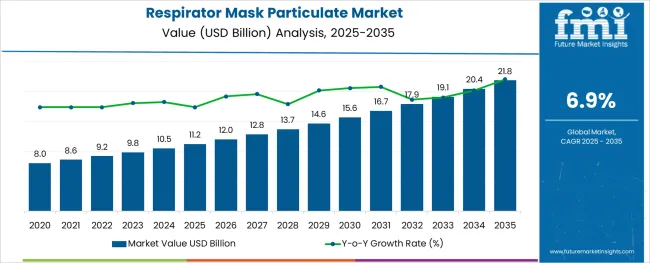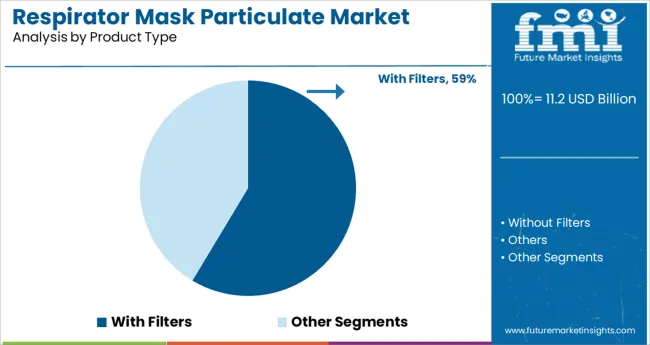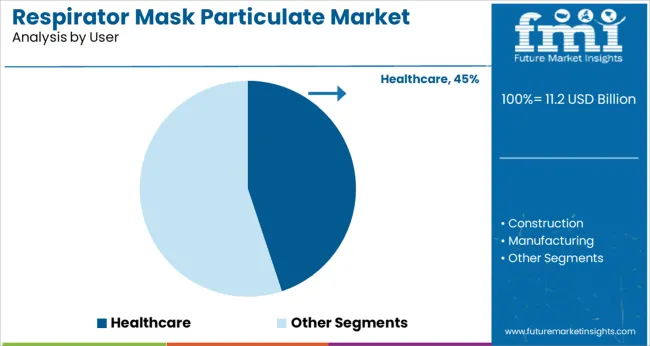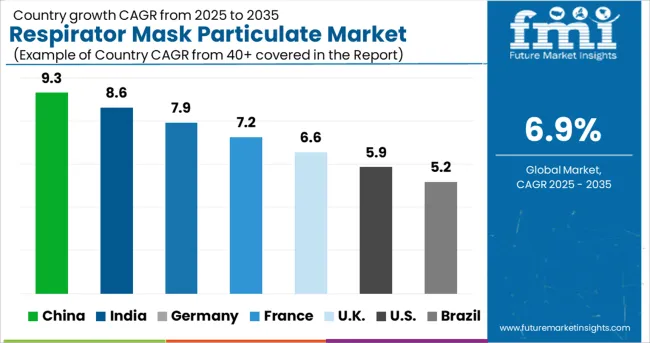The Respirator Mask Particulate Market is estimated to be valued at USD 11.2 billion in 2025 and is projected to reach USD 21.8 billion by 2035, registering a compound annual growth rate (CAGR) of 6.9% over the forecast period.

The respirator mask particulate market is expanding steadily due to growing emphasis on occupational safety, infectious disease control, and air pollution mitigation. Rising awareness among consumers and workers regarding airborne hazards such as fine dust, pathogens, and chemical particles has contributed to the widespread use of respirator masks across multiple sectors.
Government enforcement of workplace safety regulations and preparedness protocols for pandemics and respiratory illnesses have further reinforced adoption. Innovations in mask design including multi layer filtration, ergonomic fit, and skin friendly materials are enhancing user comfort and compliance.
In urban regions where industrial emissions and environmental pollution are prevalent, personal protective equipment such as respirator masks is becoming essential for both professional and everyday use. The outlook remains positive as demand continues to be driven by healthcare preparedness, environmental health concerns, and personal wellness trends across global populations.
The market is segmented by Product Type, User, and Distribution Channel and region. By Product Type, the market is divided into With Filters, Without Filters, and Others. In terms of User, the market is classified into Healthcare, Construction, Manufacturing, Oil & Gas, and Others.
Based on Distribution Channel, the market is segmented into Hypermarket/Supermarket, Specialty Stores, Pharmacies, Retail Stores, and Online Store. Regionally, the market is classified into North America, Latin America, Western Europe, Eastern Europe, Balkan & Baltic Countries, Russia & Belarus, Central Asia, East Asia, South Asia & Pacific, and the Middle East & Africa.

The with filters segment is anticipated to represent 58.60% of total market revenue by 2025 within the product type category, making it the leading segment. This dominance is attributed to its ability to provide enhanced protection against fine particulates, pathogens, and chemical agents.
Filters offer a higher level of respiratory defense compared to standard masks by capturing airborne contaminants more effectively. Their application is widely preferred in high risk settings including medical facilities, construction zones, and manufacturing units where exposure to airborne particles is significantly elevated.
The adaptability of filter masks to varying protection standards such as N95 or FFP2 has also contributed to their broader acceptance. As regulatory authorities and institutions prioritize user safety and filtration efficacy, this segment continues to maintain its leading position through its superior protection capabilities.

The healthcare segment is expected to hold 44.90% of total market revenue by 2025 under the user category, making it the dominant application segment. This growth is being driven by stringent infection control measures, rising prevalence of airborne diseases, and increased use of respirator masks in hospitals, clinics, and diagnostic centers.
Healthcare workers rely on particulate respirators as a frontline defense against exposure to pathogens, especially during procedures involving close contact or aerosol generation. Institutional protocols for personal protective equipment usage have strengthened demand for high performance respirator masks.
Additionally, training programs and supply chain preparedness initiatives within healthcare systems are supporting consistent adoption. As public and private healthcare providers enhance focus on frontline worker safety, the healthcare user segment continues to lead the market due to its critical operational needs and regulatory mandates.
People going to places for work were mandated to wear masks by government to avoid infection chances. Such demand helped the respiratory masks market to rise.
Another cause for rising demand is the deterioration of air quality in both developed and developing countries. Increased pollution has resulted in increased exposure to a variety of hazardous chemical compounds and toxins. All of these factors have contributed to the development of chronic respiratory illnesses and disorders.
To protect personnel from dangerous substances, several industries use respirators and face masks. Particulate matter can cause asthma and other chronic respiratory illnesses in many manufacturing plants and construction sites in particular.
To raise awareness about the health benefits of these respirator masks, the government and manufacturers launched several initiatives, commercials, and unique collaborations with influencers.
These excellent marketing strategies contributed to increased sales and market growth by raising knowledge of the benefits of wearing face masks
There are some adverse effects of the respiratory masks particulates, if used for longer time period. Continues use of the respirator masks can cause headache and cognitive impairment. Individuals with sensitive skin faced with skin irritation, rashes and acne after continuous use of these respirator masks.
Due to these common problems associated with continuous use of respirator masks, many people avoided using them or searched for other comfortable alternatives.
Changes in raw material prices are another impediment to the respirator mask particulate industry. These respirator masks are composed of a unique woven cloth and include several plastic components in various configurations.
All of these commodities had varying and ceasing supply to manufacturers, resulting in fluctuating end product costs, availability, and profitability.
Counterfeit goods are another market constraint. Many well-known brands are victims of counterfeit goods. Fake masks producers replicate the product designs and packaging of the best-selling brand and make counterfeit versions with bad quality and low pricing. These rates entice shoppers while reducing sales of reputable producers.

China was the main market for the face protective masks and respirator masks. Even before the pandemic, Chinese people used the face masks to be safe from any infections.
During the pandemic and currently, China is observing high demand for the respirator masks and is also becoming one of the top manufacturers and providers worldwide. Even though, 3M, an American respirator mask manufacturer dominated the respirator mask market in China.
Particularly N95 respirators are having high demand in India. The healthcare workers are widely using them due to their effective protection from particulate matters.

Some key players in the respirator mask particulate market are 3M, O&M Halyard, The Gerson Company, Medline Industries Inc., Alpha Pro Tech., Ansell Ltd., Medisca Inc., Makrite, Prestige Ameritech, Kimberly-Clark Corporation, Cardinal Health, Honeywell International Inc., Moldex-Metric and others. These are popular and well-known brands all over the world.
| Attribute | Details |
|---|---|
| Growth Rate | CAGR of ~6.9% from 2025 to 2035 |
| Base year for estimation | 2024 |
| Historical Data Available for | 2020 to 2024 |
| Forecast Period | 2025 to 2035 |
| Quantitative units | Revenue in billion, volume in Units, and CAGR from 2025 to 2035 |
| Report coverage | Revenue forecast, volume forecast, company ranking, competitive landscape, growth factors, and trends, pricing analysis |
| Segments covered | Product Type, User, Distribution Channel, Region |
| Country scope | USA, Canada, Mexico, Germany, UK, France, Italy, Spain, Russia, India, Thailand, China, India, Japan, Australia, Brazil, Argentina, Colombia, Saudi Arabia, UAE, South Africa |
| Key Companies Profiled | 3M; O&M Halyard; The Gerson Company; Medline Industries Inc.; Alpha Pro Tech.; Ansell Ltd.; Medisca Inc.; Makrite; Prestige Ameritech; Kimberly-Clark Corporation; Cardinal Health; Honeywell International Inc.; Moldex-Metric; Others |
| Customization scope | Free report customization (equivalent to up to 8 analysts working days) with purchase. Addition or alteration to country, regional & segment scope. |
| Pricing and purchase options | Avail customized purchase options to meet your exact research needs. |
The global respirator mask particulate market is estimated to be valued at USD 11.2 billion in 2025.
It is projected to reach USD 21.8 billion by 2035.
The market is expected to grow at a 6.9% CAGR between 2025 and 2035.
The key product types are with filters, without filters and others.
healthcare segment is expected to dominate with a 44.9% industry share in 2025.






Our Research Products

The "Full Research Suite" delivers actionable market intel, deep dives on markets or technologies, so clients act faster, cut risk, and unlock growth.

The Leaderboard benchmarks and ranks top vendors, classifying them as Established Leaders, Leading Challengers, or Disruptors & Challengers.

Locates where complements amplify value and substitutes erode it, forecasting net impact by horizon

We deliver granular, decision-grade intel: market sizing, 5-year forecasts, pricing, adoption, usage, revenue, and operational KPIs—plus competitor tracking, regulation, and value chains—across 60 countries broadly.

Spot the shifts before they hit your P&L. We track inflection points, adoption curves, pricing moves, and ecosystem plays to show where demand is heading, why it is changing, and what to do next across high-growth markets and disruptive tech

Real-time reads of user behavior. We track shifting priorities, perceptions of today’s and next-gen services, and provider experience, then pace how fast tech moves from trial to adoption, blending buyer, consumer, and channel inputs with social signals (#WhySwitch, #UX).

Partner with our analyst team to build a custom report designed around your business priorities. From analysing market trends to assessing competitors or crafting bespoke datasets, we tailor insights to your needs.
Supplier Intelligence
Discovery & Profiling
Capacity & Footprint
Performance & Risk
Compliance & Governance
Commercial Readiness
Who Supplies Whom
Scorecards & Shortlists
Playbooks & Docs
Category Intelligence
Definition & Scope
Demand & Use Cases
Cost Drivers
Market Structure
Supply Chain Map
Trade & Policy
Operating Norms
Deliverables
Buyer Intelligence
Account Basics
Spend & Scope
Procurement Model
Vendor Requirements
Terms & Policies
Entry Strategy
Pain Points & Triggers
Outputs
Pricing Analysis
Benchmarks
Trends
Should-Cost
Indexation
Landed Cost
Commercial Terms
Deliverables
Brand Analysis
Positioning & Value Prop
Share & Presence
Customer Evidence
Go-to-Market
Digital & Reputation
Compliance & Trust
KPIs & Gaps
Outputs
Full Research Suite comprises of:
Market outlook & trends analysis
Interviews & case studies
Strategic recommendations
Vendor profiles & capabilities analysis
5-year forecasts
8 regions and 60+ country-level data splits
Market segment data splits
12 months of continuous data updates
DELIVERED AS:
PDF EXCEL ONLINE
Respirator Fit Tester Market Size and Share Forecast Outlook 2025 to 2035
Respiratory Trainer Market Size and Share Forecast Outlook 2025 to 2035
Respiratory Distress Syndrome Management Market Size and Share Forecast Outlook 2025 to 2035
Respiratory Analysers Market Size and Share Forecast Outlook 2025 to 2035
Respiratory Protective Equipment Market Size and Share Forecast Outlook 2025 to 2035
Respiratory Measurement Devices Market Size and Share Forecast Outlook 2025 to 2035
Respiratory Heaters Market Trends and Forecast 2025 to 2035
Respiratory Pathogen Testing Kits Market Insights - Growth & Forecast 2025 to 2035
Respiratory Inhaler Devices Market Report – Size & Forecast 2025-2035
Understanding Market Share Trends in Respiratory Inhaler Devices
Respiratory Gating Market Analysis – Size, Share & Forecast 2025-2035
Respiratory Device Market Insights – Growth & Forecast 2024-2034
Global Respiratory Biologics Market Analysis – Size, Share & Forecast 2024-2034
Home Respiratory Therapy Market – Growth & Forecast 2025 to 2035
Japan Respiratory Inhaler Devices Market Size and Share Forecast Outlook 2025 to 2035
Swine Respiratory Diseases Treatment Market Analysis - Size and Share Forecast Outlook 2025 to 2035
Human RSV Treatment Market Insights - Innovations & Forecast 2025 to 2035
Upper Respiratory Tract Infection Treatment Market
Germany Respiratory Inhaler Devices Market Insights – Demand, Trends & Outlook 2025-2035
Chronic Respiratory Diseases Treatment Market

Thank you!
You will receive an email from our Business Development Manager. Please be sure to check your SPAM/JUNK folder too.
Chat With
MaRIA